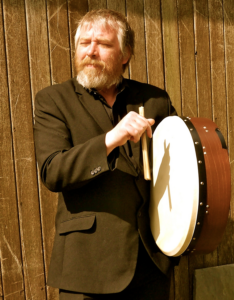 The bodhrán, though not particularly well-known to people unfamiliar with Celtic music, I imagine is a beautiful Irish frame drum. I have one actually, and can kind of play it. Kind of. Anyway, the way it works is that goat skin (or some other kind of animal skin or a synthetic material) is stretched across one side of the drum’s frame (which is made of wood … something a residential cleaning company Hamilton ON would appreciate), and the other side is left open to allow the musician to place his or her hand on the inside of the drum against the skin to control the timbre and pitch. The drums can range from 25 to 65 centimetres across, with sides somewhere from 9 to 2o centimetres deep.
The bodhrán, though not particularly well-known to people unfamiliar with Celtic music, I imagine is a beautiful Irish frame drum. I have one actually, and can kind of play it. Kind of. Anyway, the way it works is that goat skin (or some other kind of animal skin or a synthetic material) is stretched across one side of the drum’s frame (which is made of wood … something a residential cleaning company Hamilton ON would appreciate), and the other side is left open to allow the musician to place his or her hand on the inside of the drum against the skin to control the timbre and pitch. The drums can range from 25 to 65 centimetres across, with sides somewhere from 9 to 2o centimetres deep.
Where and when the bodhrán actually came into being is a mystery, contested among scholars. Some say that it came to Ireland from Africa, through Spain, while still other suggest that it came from Central Asia through Europe. Either way, it seems that there is consensus, among those people, at least, that the drum did not originate in Ireland. That said, there are some who believe that it did originate in rural Ireland, some claiming that it is a work-tool-turned-instrument, others suggesting that it was created as a way to drive up the price of goat skin. Pretty sneaky, if that’s the case.
The bodhrán didn’t really gain popularity, even in Ireland, for the most part, until the mid-20th century, when Seán Ó Riada used it in some of his compositions for a group that would later become the very popular band, the Chieftains. You can play the bodhrán either by hitting it with your hands or by using a wooden stick, which can be called a tipper, a beater, or a cipín. As you can imagine, hitting a taut goatskin with a wooden stick can create quite the sound.
And according to historical records, the bodhrán was, in fact, used in 1603 during the Irish rebellion, as the troops marched into war. Just as you can imagine the Scottish pipers seeming quite a formidable foe coming at you with their bagpipes, surely an army of Irishmen coming at you with their drums keeping time for their marching wouldn’t have been a particularly welcome sight either. There are theories (I know, more theories) that suggest that the bodhrán may originate from an ancient Celtic war drum … admittedly, although the bloodiest possibility we’ve encountered so far, I think maybe it’s my favourite. Sue me.
Apparently, the bodhrán can be a bit of a tricky instrument to play, not necessarily because it’s terribly difficult, but because there is a stigma associated with it among session-goers that it’s the instrument of the poor musician, who wants to take part in the session without having to put in as much practice or effort as, say, the fiddler of the guitar player. But I guess those sub-par musicians are pretty easy to weed out. Because they’re awful, and they make the bodhrán overpowering. It takes a true musician to play the bodhrán properly, that is, to be the low, steady heartbeat of the session, being present, but not overpowering. It’s just as important to know when to be part of the background as it is to be the centre of attention.